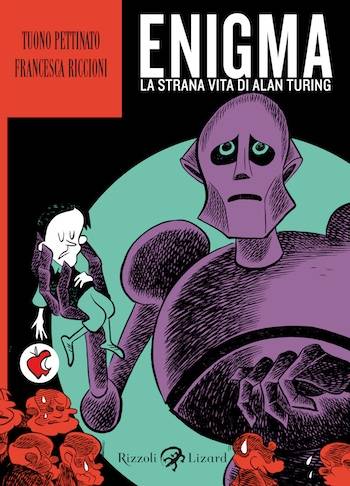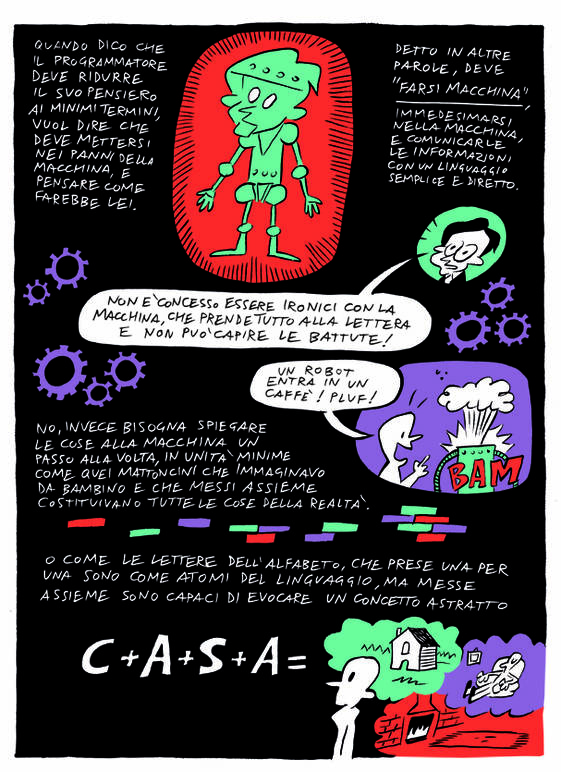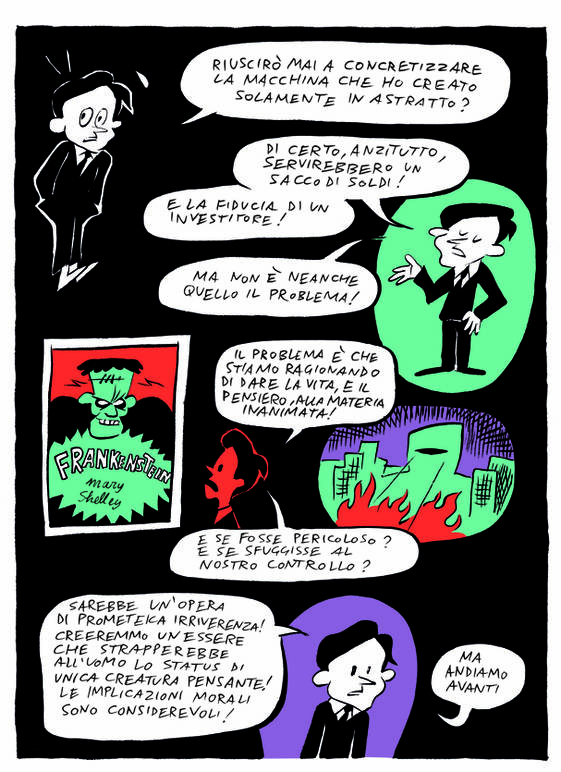Francesca, Tuono and "The Strange Life of Alan Turing"
Although not an unknown art form, comics and graphic novels are not highly popular in Italy. There are but a few comics that managed to cross borders and be read and appreciated by an American reader.
The two most famous Italian comic writers, whom were able to reach the American audience are Guido Crepax and Hugo Pratt (pseudonym). They created the iconic characters of Valentina (a photographer from Milan in love with a super-hero, symbol of the progressive spirit of the 1960s in regards to sex, politics, sci-fi) and Corto Maltese (a sailor who goes on adventures, with historical figures and on symbolic Gulliver-like travels).
Other, maybe less known writers are Francesca Riccioni and Tuono Pettinato who created Enigma. La strana Vita di Alan Turing. These two very young Italian artists, without important connections and in spite of the difficulties of making it in today’s job market- got together, wrote, illustrated and published a book with Rizzoli, one of the most prominent publishing houses in the country. The book is currently selling very well and it will be translated into different languages.
Francesca Riccioni has a Bachelor degree in Physics and a Master degree in Communications: the right combination to be able to explain, share and ultimately creatively narrate even the most obscure scientific ideas. Tuono Pettinato (aka Andrea Paggiaro) is a well-established comic artist with a comic strip on Repubblica XL.
This graphic novel brings attention to the scientific side of Italy, a side that from abroad, except maybe recently with the enormous loss of Rita Levi Montalcini, the Nobel Prize winner-scientist, is not often associated with scientific topics and technological advancement.
Moreover, the philosophical implications of technology, its cultural revolution, the history of International figures such as Alan Turing (who - in a nutshell - created the main algorithms and patterns that make him the “father of the computer”) are not as well taught and spread, as they should be.
It’s a topic that speaks to different generations but particularly captures today’s “Zeitgeist” linked to our technological consumption, a technology that has literally become artificial intelligence (Siri, Google, etc), that is an extension of our personalities and emotions, with all its pros and cons, something that Alan Turing foreshadowed not just with his inventions but with his own life.
The book takes us through Alan Turing’s life in a creative way, starting from a quick glimpse of his childhood, transfering from school to school. The book reminds us of movies such as “The Social Network” or the 1980’s “War Games.” In both, the characters don’t necessarily need to be taken literally, but more within their human realm, as they explain the bigger ideas that lie within a technological invention. Their coming of age coincides with a bigger coming of age that the world will go through. Alongside Turing we learn a few key mathematical ideas explained in a witty, brief manner already implying or foreshadowing the bigger cultural and historical consequences they will have.
Turing’s life was far from being idyllic. Turing, a loner, attended the most prestigious schools and colleges in the United Kingdom that in the 1930s were also known to be places of harsh punishments and humiliation. Without spoiling the story (although it’s based on his life), after he suffers a tragic loss of one of the people he cared about, something is triggered in him: the idea of not just thinking of a machine as something outside of you, something that replaces human interaction, but of a machine that can replicate human thought.
The book balances well the pros and cons of this concept: on one side it’s brilliant to put oneself in the shoes of a machine, think like one to understand how something works, on the other it leads to a refusal of life itself. The story intertwines history, the rise of Nazism and a particular obsession that Turing had as a young man: the Disney’s version of Snow White. That movie had a shocking effect on him, on his thoughts and imagery. The poisoned apple, which will come to haunt Turing to the point that it will be connected to his actual death, reminds us of something very popular today. Steve Jobs’ products: the iPhones, iPods, etc with their iconic symbol, are probably not inspired at all by Turing but one cannot help but tie everything together while reading this passionate re-telling of how the dichotomy and connection between emotions and technology began.
Snow-White’s evil Queen comes into the story in the shape of Hitler, showing a man who actually thinks like a machine and dehumanizes the world. Yet, Turinig’s response to these dark times is a sort of search of something scientific, which creates human connection. Enigma. La strana Vita di Alan Turing is not a story for children nor a scientific essay for adults. It makes us understand that technology is not magic, but the process of rational thought of geniuses like Turing. Yet, the idea of magic is in some way linked with technology and science, for magic, in its good or evil form, is about changing the elements inside someone or something, reprogramming a person or changing the course of the world forever.








































i-Italy
Facebook
Google+
This work may not be reproduced, in whole or in part, without prior written permission.
Questo lavoro non può essere riprodotto, in tutto o in parte, senza permesso scritto.